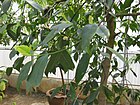Note: This is a project under development. The articles on this wiki are just being initiated and broadly incomplete. You can Help creating new pages.
Difference between revisions of "Garcinia cowa"
| Line 1: | Line 1: | ||
[[File:Gardenology.org-IMG 8173 qsbg11mar.jpg|thumb|right]] | [[File:Gardenology.org-IMG 8173 qsbg11mar.jpg|thumb|right]] | ||
| − | '''Garcinia cowa''' is an evergreen tree growing 8 - 12 metres tall. The bole can be 15 - 20cm in diameter. The tree is harvested from the wild for its edible fruits and leaves, which are used locally. | + | '''Garcinia cowa''' is an evergreen tree growing 8-12 metres tall. The bole can be 15-20cm in diameter. The tree is harvested from the wild for its edible fruits and leaves, which are used locally. |
==Uses== | ==Uses== | ||
{{Uses|}}, {{Uses|}}, {{Uses|}}, {{Uses|}}, {{Uses|}}, {{Uses|}}, {{Uses|}}, {{Uses|}}, {{Uses|}}, {{Uses|}}, {{Uses|}}.<ref name="Uses"/> | {{Uses|}}, {{Uses|}}, {{Uses|}}, {{Uses|}}, {{Uses|}}, {{Uses|}}, {{Uses|}}, {{Uses|}}, {{Uses|}}, {{Uses|}}, {{Uses|}}.<ref name="Uses"/> | ||
| Line 8: | Line 8: | ||
==Chemical Composition== | ==Chemical Composition== | ||
| − | <ref name="chemical composition"/> | + | Garcinia cowa is an abundant source of bioactive phytochemicals. Phytochemical |
| + | investigations of the plant parts indicated that the fruit, twig and stem are the best source of secondary metabolites, providing flavonoids, phloroglucinols and xanthones respectively.<ref name="chemical composition"/> | ||
==Common names== | ==Common names== | ||
| Line 66: | Line 67: | ||
<references> | <references> | ||
| − | <ref name="chemical composition">[Chemistry]</ref> | + | <ref name="chemical composition">[https://pdfs.semanticscholar.org/3864/1a82cbbf26d272a1da154c42164780bc68d1.pdf Chemistry]</ref> |
<ref name="Leaf">[Morphology]</ref> | <ref name="Leaf">[Morphology]</ref> | ||
Latest revision as of 15:33, 22 May 2020
Garcinia cowa is an evergreen tree growing 8-12 metres tall. The bole can be 15-20cm in diameter. The tree is harvested from the wild for its edible fruits and leaves, which are used locally.
Contents
- 1 Uses
- 2 Parts Used
- 3 Chemical Composition
- 4 Common names
- 5 Properties
- 6 Habit
- 7 Identification
- 8 List of Ayurvedic medicine in which the herb is used
- 9 Where to get the saplings
- 10 Mode of Propagation
- 11 How to plant/cultivate
- 12 Commonly seen growing in areas
- 13 Photo Gallery
- 14 References
- 15 External Links
Uses
[[:Category:Ayurvedic Herbs known to be helpful to treat |]], [[:Category:Ayurvedic Herbs known to be helpful to treat |]], [[:Category:Ayurvedic Herbs known to be helpful to treat |]], [[:Category:Ayurvedic Herbs known to be helpful to treat |]], [[:Category:Ayurvedic Herbs known to be helpful to treat |]], [[:Category:Ayurvedic Herbs known to be helpful to treat |]], [[:Category:Ayurvedic Herbs known to be helpful to treat |]], [[:Category:Ayurvedic Herbs known to be helpful to treat |]], [[:Category:Ayurvedic Herbs known to be helpful to treat |]], [[:Category:Ayurvedic Herbs known to be helpful to treat |]], [[:Category:Ayurvedic Herbs known to be helpful to treat |]].[1]
Parts Used
Chemical Composition
Garcinia cowa is an abundant source of bioactive phytochemicals. Phytochemical investigations of the plant parts indicated that the fruit, twig and stem are the best source of secondary metabolites, providing flavonoids, phloroglucinols and xanthones respectively.[2]
Common names
| Language | Common name |
|---|---|
| Kannada | |
| Hindi | |
| Malayalam | |
| Tamil | |
| Telugu | |
| Marathi | |
| Gujarathi | |
| Punjabi | |
| Kashmiri | |
| Sanskrit | |
| English |
Properties
Reference: Dravya - Substance, Rasa - Taste, Guna - Qualities, Veerya - Potency, Vipaka - Post-digesion effect, Karma - Pharmacological activity, Prabhava - Therepeutics.
Dravya
Rasa
Guna
Veerya
Vipaka
Karma
Prabhava
Habit
Identification
Leaf
| Kind | Shape | Feature |
|---|---|---|
Flower
| Type | Size | Color and composition | Stamen | More information |
|---|---|---|---|---|
| {{{5}}} |
Fruit
| Type | Size | Mass | Appearance | Seeds | More information |
|---|---|---|---|---|---|
Other features
List of Ayurvedic medicine in which the herb is used
Where to get the saplings
Mode of Propagation
[[:Category:Index of Plants which can be propagated by |]]
How to plant/cultivate
Commonly seen growing in areas
Humid mixed forests, Hill area, In Valleys.
Photo Gallery
References
External Links
- Ayurvedic Herbs known to be helpful to treat
- Herbs with Fruits used in medicine
- Herbs with Leaves used in medicine
- Habit - Evergreen tree
- Index of Plants which can be propagated by
- Herbs that are commonly seen in the region of Humid mixed forests
- Herbs that are commonly seen in the region of Hill area
- Herbs that are commonly seen in the region of In Valleys
- Herbs
- Pages without herbs images



